Entries in clothes (10)
Back in the Smock
Probably nobody is wondering, but just in case one little person out there is dying to know, I thought I’d update you on the latest in the smock experiment. I’m back in the smock, this time without all the fall-winter layers underneath. I love the bare legs and boots, as you can see in the photo below, but I will confess that it’s a lot of dress for the hotter/more humid days. By the last days of this month – the end of this smock’s tenure – I will probably be sporting sandals and a tank and sweating to get to July 1.
A few things are different about it this time. For one thing, the novelty’s worn off a little. In 2008 I’m not not buying anything, so the transgressiveness of the smock being one of the few things I’ve purchased this year is moot. I guess it was giving me a little charge every time I wore it. For another, my office eliminated its dress code early this year, so the boundaries between the smock and my work clothes are a lot less clear. It seems I liked the definition or divide it was providing between work and the rest of my life. I was wearing it about once a week even with the dress code, but I would carefully consider if my boots looked nice enough or if the shirt I was wearing underneath was one of my “dressier” ones. Somehow these little subtleties made the experiment feel more rigorous. Now I’ll just end up in it because I forgot to bring something else or I’m going somewhere after work and it’s easier not to change.
Wearing it for every single thing may be closer to Andrea Zittel’s original idea for the smock, but my version of the experiment helped me make some very interesting distinctions between my social/art life and the other things that I do. I started seeing activities as “in” activities or “out” activities, which didn’t necessarily correspond with leaving my apartment. For example, going to the corner store to get a pint of milk is definitely “staying in.” But going to the museum, even if I was going by myself and only to catch something quickly, is definitely “out.” And certain friends I found myself more compelled to wear the smock with and others I didn’t; with my former neighbors, for example, I don’t always feel it necessary to wear the smock, even if I’m technically “going out.”
All this has made me think very carefully about fashion and its role in my life. I’ve gotten really interested in the politics and subtleties of how clothes represent us, and I’ve been inspired to put together a few proposals for new performance projects about fashion. I’ll let you know how everything turns out – a new blog may be in the works!
Clothes!
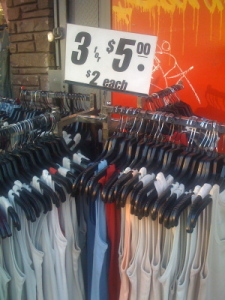 Those of you keeping track will notice that a good quarter of the things I've purchased in 08 have been clothes. Frankly, I've done more shopping in the last two months than I did in the previous two years. I'm shocked that it's managed to keep my interest -- I guess the research-project aspect of it and more money to spend have made it tolerable. There's a huge spectrum of options out there, ranging from sweatshop-tastic to mittens made from pampered bunnies hand-combed to yield a special angora. I thought I'd report back, and pose some questions to the people out there challenged by similar issues.
Those of you keeping track will notice that a good quarter of the things I've purchased in 08 have been clothes. Frankly, I've done more shopping in the last two months than I did in the previous two years. I'm shocked that it's managed to keep my interest -- I guess the research-project aspect of it and more money to spend have made it tolerable. There's a huge spectrum of options out there, ranging from sweatshop-tastic to mittens made from pampered bunnies hand-combed to yield a special angora. I thought I'd report back, and pose some questions to the people out there challenged by similar issues.
At the "worst for the environment and for people" end of things, I finally went to H&M to redeem the gift certificates I received last summer. I didn't actually spend any of my money though I did articulate the opinion that cheap throwaway clothes - jeans and a work shirt - are something people want. I noticed one shirt in the store that was made of organic cotton, a step in the right direction, but I didn't need it for anything and it was ugly besides. I have a couple more certificates that I will use, and then I will try to say goodbye to H&M forever. It's been a mainstay for basics and things that don't get heavy use, like work clothes.
I also went into Old Navy to look for some T-shirts that a friend recommended. They didn't have a single one in my size, so I cruised over to the clearance table. $2.99 for a long-sleeved tee! Wow! -- But wait, it's a funny color. -- But it's only $2.99! And it looks really cozy! -- "Made in El Salvador." 'Made in Vietnam." "Made in Cambodia." -- I started to feel a little sick: this shirt definitely didn't cost $2.99. I know it's just a little 8oz shirt but I'm sure there's a fuel cost -- and packaging costs and equipment costs and the costs of paying the Old Navy workers, not to mention the amount the Vietnamese factory worker SHOULD be getting. Increasingly freaked, I just walked out of the store.
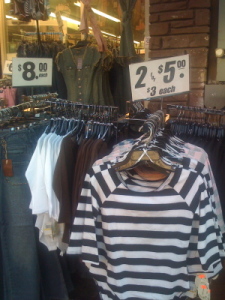 I still need t-shirts. The ones I bought a couple of years ago are worn out completely. Not only do they have to be the right size, have the right feel, the right weight, the right colors, it would be great if they could be made locally of organic cotton in a certified fair-trade environment. But I don't think they have local organic fair-trade t-shirts. So I have to pick one or some of these criteria. I will probably be able to afford a couple American Apparel shirts (sweatshop free?), but their organic selection is very small. I don't know of any major retailer who is making basic organic cotton t-shirts that I can try on somewhere. Most of the organic clothes places I've found make stuff that seems pretty coarse and hippie-ish. Let me know if you have any ideas.
I still need t-shirts. The ones I bought a couple of years ago are worn out completely. Not only do they have to be the right size, have the right feel, the right weight, the right colors, it would be great if they could be made locally of organic cotton in a certified fair-trade environment. But I don't think they have local organic fair-trade t-shirts. So I have to pick one or some of these criteria. I will probably be able to afford a couple American Apparel shirts (sweatshop free?), but their organic selection is very small. I don't know of any major retailer who is making basic organic cotton t-shirts that I can try on somewhere. Most of the organic clothes places I've found make stuff that seems pretty coarse and hippie-ish. Let me know if you have any ideas.
The closest I got to local clothing was buying some stuff from a couple of New York designers that I really like. They're not still small enough to be manufacturing the stuff by hand in the shop, like when they started, but they are both quite involved in the production and sales of their designs. Meg, one of them, told me how she's trying to move her Pakistani fabricating shop into the same building as the store -- she's been working with the same guy for 15 years. As her business has grown, she has expanded to factories in Canada, Asia, and the Middle East; she told me she's visited every one. It was fun chatting with her about this: I felt a little like I do at the farmer's market.
I also had fun trying some stuff from Nau, a new company that is trying to be both fashionable and sustainable. They use exclusively renewable materials and sustainable processes and describe their sources on their site; I was also impressed by how little packaging the stuff arrived in - just a small envelope made of recycled paper. The cost of these wonderful things is normally beyond my reach; I am looking forward to their New York sale March 6-9. Finally, I bought a pair of shoes for work and for fun; not explicitly "sustainable," they seem to be of high-quality materials and made to be repaired. Shortly afterward, I found this company online: I will look forward to checking out the Terra Plana store in New York when I need shoes again.
I should be clear that I don't think products are the answer to our environmental and social problems. I think as a culture we buy and throw away too many things that we never used and never needed. Of course the things we do need - t-shirts, shoes, toilet paper - must be produced in better ways or soon enough they won't be produced at all. We'll be digging them out of old landfills. With that in mind, at the end of all of this shopping, I went to another clothing swap, the most fun way to get new clothes.

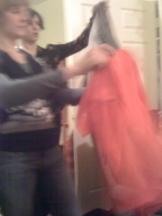
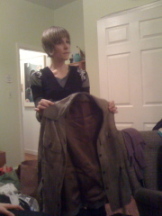
The shopping I did was really shopping: that is, I looked at labels and asked questions and tested things out and compared items. It's time-consuming and things aren't so transparent. At the end of it all, it became even clearer to me that buying used or refashioning something old is the most people- and earth-friendly way to go for a new getup. Still, it's really nice to have something fresh and new every once in a while.
I'm sorry if I let you down

I went back to the gallery three times before I actually bought it. I've been wearing it as a uniform, every day, which is having powerful effects. I'm waffling about the office: I've worn it all day there though I haven't been quite brave enough to wear it every single day - my boss even gave me her blessing. I've been telling myself I need a little separation between work and not-work and the clothes that I wear there (which are so limited they are like a uniform, too) help me do that. Any energy I spend thinking about other clothes - dance clothes, bike-riding clothes, which of the work uniforms to wear - feels like a complete waste.
I've failed Fix in that I bought something new, something that I charged to my credit card - which I haven't done all year. At the same time, Fix is about exposing the connections between buyer and seller, getting out of the conventional mode of commercial exchange, and challenging expectations about consumption. This purchase reiterates all of the nasty things of shopping with some important differences: with a little effort, I can email the artist who made the dress and talk about the process; the gallery that sold it and earned a commission is part of the art market but not part of the fast fashion industry, trying to convince everyone that they need this now but not next week; and, the amount I spent on this little item and the ideology behind it ensures that it won't go into the landfill after a couple of wears. Let's say I bought a really expensive prototype; I'll make the next one.
I'll leave you with the press release for the smockshop show, which helped convince me that Andrea Zittel wasn't kidding herself about the smocks. She knows that they're fashion; she's trying to get a little art in there too.
I can't stop thinking about
a dress. This is so problematic in so many ways. With all my talk about "making do and mending" and the absurd expectations placed on us by the fashion and beauty industries, I can't believe I've allocated any brain space on the beautiful item. Most breathtaking is the fact that the dress costs $340. I've never spent that much on any piece of clothing, shoes and coats included. And still I've been trying to arrange and re-arrange the various extra little amounts and overtime I've earned in the last couple of months to rationalize the price tag. Then there's the "new" thing: this particular dress can be justified by Fix rules - more on that in a sec - but the fact remains that buying it would give me the delicious rush of bringing home a gorgeous new thing.
A little more about the dress: it's part of a project by artist Andrea Zittel, a big hero of mine. I saw it at a Chelsea gallery last Thursday, and it set in motion a whole chain of ideas that both totally violate Fix and are oddly in line with it. I told myself I was going to look at art and I knew in advance that the dresses were going to cost $250-350 -- out of the question. According to the smockshop site:
"A smock is a simple double wraparound garment designed by Andrea Zittel. These versatile garments are both attractive and utilitarian - each garment is one of a kind, and is sewn by an artist who reinterprets the original design based on their individual skill sets, tastes and interests.
The smockshop generates income for artists who’s work is either non-commercial, or not yet self sustaining."
After pathetic lingering and admiring, I decided that just trying one on wouldn't hurt, and I chose an orange canvas utilitarian model with an unfinished neckline and a navy cotton dressy one by a different artist with a hot pink lining and contrasting embroidery. While the orange one was very punk rock and looked good, it was the embroidered one that chose me. The smocks are amazing on - they have a great line that I imagine would flatter anyone; the minimalist yet feminine aesthetic feels exactly my style. Of course I love the idea of wearing the same thing every day, I practically do that anyway. Andrea Zittel has been exploring the concept of the uniform for years, with criticisms (implicit and explicit) similar to mine about fashion and expectations; all of her work, the uniforms included, is concerned with utility/functionality and explores the surprising connections between design and the patterns and requirements of a person living in space.
As I tore myself from that beautiful dress, I couldn't help but think, "I guess I'm not an emerging enough artist to get an Andrea Zittel pattern..." Does that mean I'm such an emerging artist that I'd consider scraping all my money together to buy one? Or maybe I'm just a groupie...or a latent fashionista...
I find it troubling that the smocks are a commercial enterprise - of course an artist has to make her money, and she's giving "most of the profits" (according to the gallerist) to the emerging artists. At the same time, I'm not sure many, if any, of buyers are going to: a. wear the smocks as uniforms, i.e.: every single day, for every purpose; or, b. inquire into the challenges these smocks present to the fashion and art industries, as part of Andrea Zittel's body of work. My guess is that the people who can afford the price tag also buy lots of other beautiful clothes and want to wear those, too. And if they're spending all that money on fabulous clothes, they're probably not very critical of fashion. As an art object, the dress is unbelievably cheap - but it wasn't exactly made by Andrea Zittel; if it achieves its art-object function in performance, as a uniform, it is clearly not an investment as other art objects might be - it will wear out very soon. Maybe I'm just bitter because I can't really afford it and I'm doing this project where I don't buy anything new...
As a Fix transgression, the smock might be justified as buying an experience (something I'd commit to wearing all the time not at work or cleaning or dancing), a one-of-a-kind handmade art object (still a thing, though!), or as a quasi-donation to an emerging artist (but the gallery - and Andrea, I imagine - will still get their percentages). On the other hand, I've seen the pattern, and it isn't complicated. It would take me a couple of tries on less-nice fabric to get to a perfect shape and technique; I even know how to do the hand-stitched neck and embroidery. I would have to clear the space in my office for a borrowed sewing machine, and get that machine fixed. To be quite honest, these details could potentially take me months, and by that time, this bee in my bonnet might be gone...
Gift Certificates?
Oooh, temptation! I recently received some gift certificates to a clothing store. A clothing store with no "organic" or "sustainable" options. The giver (from work) keeps asking what I've purchased. I was thinking I'd craftily put off answering until Jan 08, but now that seems silly and difficult - I mean, I'm still thinking I'll use them, right, so why not get it over with? The funny thing is, I have a cold and I'm grouchy, and still I think new clothes will make me feel better. Feeling better will make me feel better.
But new clothes would be fun.
They found me!
 I've been wanting a new pair of work shoes for a while. I thought a pair I bought over Thanksgiving would do the job for the year but they're already pretty beat up and not so comfortable. A few halfhearted looks at thrift stores didn't yield anything, and I missed my friends' most recent clothing swap. So when a girl was selling her stuff on the sidewalk outside of my Saturday dance class, I had to stop and investigate. I could tell these were a 7 and I thought they'd dutifully cheer up my all-black outfits (the picture looks a little dark - they're purple). Shortly after she bought them, the girl decided to give up on heels - these had never been worn! It pained me a little to pay $20 for shoes on the street, but hey - they found me.
I've been wanting a new pair of work shoes for a while. I thought a pair I bought over Thanksgiving would do the job for the year but they're already pretty beat up and not so comfortable. A few halfhearted looks at thrift stores didn't yield anything, and I missed my friends' most recent clothing swap. So when a girl was selling her stuff on the sidewalk outside of my Saturday dance class, I had to stop and investigate. I could tell these were a 7 and I thought they'd dutifully cheer up my all-black outfits (the picture looks a little dark - they're purple). Shortly after she bought them, the girl decided to give up on heels - these had never been worn! It pained me a little to pay $20 for shoes on the street, but hey - they found me.
salvage/selvage
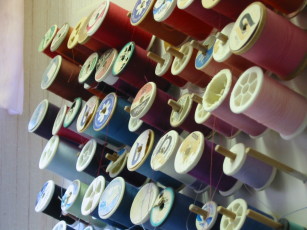 My wardrobe grew considerably in the last week, without buying a thing! My grandmother and I resurrected some clothes that had been sitting in my closet for over a year with tears, missing buttons, stains, etc. We've done mending together before but I paid closer attention this time...still, I mostly reattached buttons while she undertook complicated repairs. She and my mom had the brilliant idea of using the cuffs of a beautiful embroidered blouse as cap sleeves when the stains and rips on the long sleeves couldn't be fixed, thereby saving it from the trash. It will be a great new summer shirt.
My wardrobe grew considerably in the last week, without buying a thing! My grandmother and I resurrected some clothes that had been sitting in my closet for over a year with tears, missing buttons, stains, etc. We've done mending together before but I paid closer attention this time...still, I mostly reattached buttons while she undertook complicated repairs. She and my mom had the brilliant idea of using the cuffs of a beautiful embroidered blouse as cap sleeves when the stains and rips on the long sleeves couldn't be fixed, thereby saving it from the trash. It will be a great new summer shirt.
My grandmother is an accomplished seamstress: she made clothes for three kids and a husband in the 50s and 60s, my mom's wedding dress in '69, baby clothes and dress-ups for me and my sister in the 80s. I think her latest big project was re-lining my black winter coat - an enormous and painful job that allowed me to get an additional year or two out of a beloved style. She double-lined the pockets so my keys wouldn't shred through and attached a label that says "specially fashioned by grandmother." Way better than a designer label. She became so good at sewing because they couldn't afford store-bought clothes back in the day; she noted how today a spool of thread costs $3 and I suspect the black satin for the coat wasn't very cheap either - it's cheaper now not to sew.
I dream about sewing for myself because I admire my mom and grandmother so much in this regard. It's a totally romantic and nostalgic notion, even more so because I lack the basic patience required and my interest is largely theoretical. Still, I tried to learn as much as I could in this recent session: my grandmother showed me some tricks and above all encouraged me to get a machine so I can do some bigger repairs on my own. Once I got over the disappointment that I couldn't learn to sew in a long weekend, I decided to listen to her advice and cut myself some slack. I already have the skills to do little things, simply from years of watching her and my mom, I just can't let it pile up so much. And I might be able to develop a sewing imagination, the kind that makes cap sleeves out of cuffs, but it's going to take a lot longer than I want it to. Now, if I can cultivate the patience...!
Learning from the Master
Welcome, new readers! (Thanks to Risa at culturebot and Colin, No Impact Man.) I'm off to visit my grandmother, with a gigantic bag of mending. I'm looking forward to time away from the computer, among other things - I'll write again when I get back next week.
Swap!
 You've heard the trash-treasure adage a million times, and I'll probably repeat it often in Fix. But it's true! Last week 8 or 10 friends got together in Brooklyn to offload the random clothes that never worked or gifts we couldn't bring ourselves to wear. The good thing about clothing swaps rather than giving to Goodwill is that you have a relationship with where your stuff is going and some of the emotional details remain intact. I can get rid of the silk shirt I spent too much on because I can see that it looks way better on my friend. Even if no one bites, everyone gets a laugh out of the aunt who insists on giving her neice elaborate monochromatic outfits. Plus, among friends the respect factor goes up a little: we throw the disgusting t-shirts out rather than try to pass them off as acceptable "donations."
You've heard the trash-treasure adage a million times, and I'll probably repeat it often in Fix. But it's true! Last week 8 or 10 friends got together in Brooklyn to offload the random clothes that never worked or gifts we couldn't bring ourselves to wear. The good thing about clothing swaps rather than giving to Goodwill is that you have a relationship with where your stuff is going and some of the emotional details remain intact. I can get rid of the silk shirt I spent too much on because I can see that it looks way better on my friend. Even if no one bites, everyone gets a laugh out of the aunt who insists on giving her neice elaborate monochromatic outfits. Plus, among friends the respect factor goes up a little: we throw the disgusting t-shirts out rather than try to pass them off as acceptable "donations."
I'd estimate that at least 40% of my wardrobe consists of swap items at this point. Almost my entire work repertoire came from other nine-to-fivers who make more money than I do - I'd like to spend as little as possible on bland button-downs, sweaters, and slacks. This time, I managed to assemble a decent bag of discards despite moving a lot recently and going to a good number of swaps in the last year. I ended up with three brand-new t-shirts, a perfectly cute coat my friend's boyfriend disliked, an apron, and a book.
Treasure?

Trash!

Fast Fashion
Last week the New York Times covered the publication of Cambridge’s “Well Dressed?,” a report on the clothing and textiles industry in the UK. Clothing’s recent shift to disposability -- with stores like H&M and Old Navy pumping out cheap new stuff every week or so – spells trouble for landfills, the atmosphere, human rights, etc. etc. While generally I love H&M (basically everything in my wardrobe that I didn’t get for free is from there), I’ve been thinking a lot about this problem myself of late, and was happy to spend a little time on the subject.
The Times article lingered on the idea of leasing clothing -- probably because they hypothesized that readers would find this an icky and unrealistic idea -- and got some choice bits from a head honcho at Marks & Spencer, who thinks that the “green-ness” of clothing will soon influence consumer choice like it does for food (in some countries). I appreciated the additional voices, and was disappointed that the article couldn’t draw any comparisons between the US and UK industries. (Probably because most of the data doesn’t exist.) Most alarmingly, the NYT article glosses over the report’s decisive view of the US cotton industry, burying mention of “so-called organic cotton” at the end of the second page.
The primary ideas I took away from the “Well Dressed?” report were: 1. US cotton is catastrophic for the industry and the environment, and 2. a shift in consumer behavior is the most important way to alleviate the environmental impact of the clothing and textile industry. Perhaps I’m the last to know, but I had only a very vague notion of the energy, water, and pesticides required to produce cotton by conventional means; I also didn’t understand the extent to which US subsidies impact cotton production in other countries. [Admittedly, the report is written from a decidedly EU point of view -- I’m very curious to see what kind of conclusions an American think tank would come up with.] Of course I’d like to think greater awareness of the issue combined with better choices could enable me to make a difference. A quick inquiry revealed that American Apparel has 6 or 7 organic t-shirt and underwear options (out of hundreds of conventional options); additional organic choices come from companies that appear to make mostly yoga clothes. By the end of the Cambridge report, my choices as a consumer, to buy the right things – durable, organic – and to do the right things with them – repair them, wash them in cooler water, and hang them dry – are the “simplest action that would reduce the environmental impact of the sector.”
Which leads me to a big question: how can consumers successfully transit between the current way of thinking about clothes to an opposite one (and then possibly back again)? With the utopian ideology espoused by folks like those in Cradle to Cradle, the “fast fashion” impulse could be supported by the right design – if clothes were at once fashionable, produced with little impact on the environment, and easily disposable, we could buy as much as we want and throw away without worry. In the interim, as “Well Dressed?” suggests, we have to resist fast fashion, make do, and mend. Is this shift possible to achieve on a massive scale? Unlike the authors of the report, I think changing attitudes about clothes requires a wholesale rethinking of what we view as prosperous, safe, clean, and beautiful. In the meantime, we just feel bad and do little.
New York Times: "Can Polyester Change the World?"
University of Cambridge Institute for Manufacturing: "Well Dressed?"
Marketplace Money Report's story about the "fashion" part of eco-fashion
